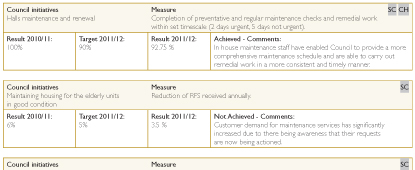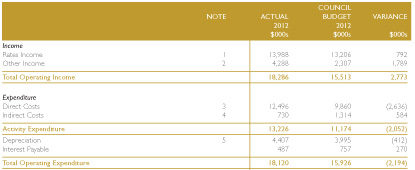At a Glance
Primary Services
- Community centres, halls, museums and pensioner housing
Why We Do It
Council recognises the importance of accessible, affordable, safe, well maintained and strategically located public meeting places across the district.Generally, Council is responsible for the exterior maintenance of halls and the local management committee is responsible for the management of the facility and interior maintenance. The activity will focus over the next 3 years to look for opportunities to divest facilities back to the community where appropriate.
Housing for the elderly is designed to meet the needs of pensioners of modest means.
What Has Changed Since The LTCCP 2009/19?
- Although the planned renewal programme for community halls has been retimed to better align with the remaining asset life of the halls assets the spending of this funding has been deferred while Council reviews its future role in the provision of community halls.
- Museum funding was increased to $120,000 in 2010/11 to be split two thirds / one third between the Far North Regional Museum and Heritage Kaikohe.
- Council has engaged in house maintenance staff
to provide a more robust and cost effective approach to maintenance of community halls and
pensioner housing. - Council is continuing the planned deferred maintenance programme for pensioner housing that was funded from the sale of the Mangonui pensioner units.
- Pensioner housing rent will increase on the 1st October each year by the CPI index and Council has also introduced market rents for tenants who do not meet the pensioner age criteria.
- Council has adopted a non smoking policy for all new tenants in the pensioner housing units.
- Council will continue to work with social housing providers to find a more sustainable solution to the management of the remaining pensioner housing complexes over the next 5 years.
Priorities For 2011/12 |
What We Have / Haven't Achieved |
|---|---|
| Using the funds from the Mangonui pensioner housing sale to complete deferred maintenance on other pensioner units over the next 2 years | Council has achieved this priority and has completed 70% of the deferred maintenance. We have achieved the reroofing of the Kaikohe pensioner housing complex along with the insulation of the majority of units within the portfolio. |
| Continuing to work with the Far North Regional Museum to ensure a smooth transition into the Te Ahu centre | The Far North Regional Museum has been relocated to Te Ahu. Council is finalising arrangements for continued use of the former museum building for storage purposes. A positive working relationship with the museum has ensuredthe smooth transition into Te Ahu. |
| Reassessing, in consultation with the community, Council's role in owning, maintaining and promoting community halls | This priority has not been achieved and will be included in the 2012/22 LTP. |
| Continuing to support key local community hubs such as Te Ahu and The Turner centre | Council has achieved this priority by providing additional management support for both facilities. |
Future Issues / Challenges |
Implications |
|---|---|
| Council needs to balance maintenance and upgrade costs of community halls and buildings with what the community can afford. The cost of depreciation provision for asset renewal is a significant burden on the budget | These issues call for a fundamental reappraisal, in consultation with the community, of Council's role in owning, maintaining and promoting these facilities. Council would like to assist community groups so they can access alternative funding to reduce the potential of increased ward rates. |
| Hall use has declined over recent years as a wider choice of venues is now available to the community. | Council will need to identify the facilities that have strategic importance to the community and which should be retained in Council ownership. |
| Not all of Council's community halls and buildings meet modern building standards that require barrier free access into the building and suitable toilet facilities | Upgrading hall and community buildings to meet the current building standards will require additional ward rates. In some cases upgrading will not be easy to achieve due to barriers, such as insufficient space available to install a compliant ramp to access Mangonui hall within the property. Council would like to align these upgrades with the divestment project. |
| Council will be considering amalgamating Council facilities and services in Kaikohe in a similar way to the Te Ahu development completed in Kaitaia. The intended outcome of this proposal would be a central civic building providing a range of services, and could include partnerships arrangements | Until the business case for this concept has been further developed, no major upgrades will be undertaken to the Kaikohe library, Kaikohe memorial hall, or the district office. |
| Even with increased maintenance the occupancy level in the Kohukohu pensioner complex has declined over recent years. The village has a very small population and 6 units may be over supply | Council consulted with the community about the future of the Kohukohu units and has decided to seek expressions of interest from community groups on how these may be managed in the future. |
| As Treaty Settlements are finalised, there may be an opportunity to work with iwi to explore options for divestment of the pensioner housing activity. This may offer a more sustainable future for the housing stock, while also safeguarding the interests of residents | As Council has no control over the Treaty Settlement process, it may need to be flexible with the timeframe for a long term solution so that iwi can be involved in investigating more sustainable approaches to managing pensioner housing. |
Highlights of Performance

TPM = Total number of Performance Measures
 Performance 2010/11 vs. 2011/12 - is neutral
Performance 2010/11 vs. 2011/12 - is neutral
Statement of Service Performance
For COMMUNITY CENTRES, HALLS, MUSEUMS and PENSIONER HOUSING the following pages detail:- Service performance information provides levels of service comparative results for 2010/11 and 2011/12 including achievements and issues.
- Financial performance including comparisons against budget 2011/12.
 Print the above sections
Print the above sections

